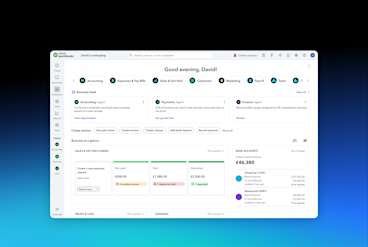
Cloud accounting
Automation vs AI vs Agentic: What every accountant should know
Simple, smart accounting software - no commitment, cancel anytime

GROWING YOUR BUSINESS
If you want to sell products or services on the internet, you need to be able to accept payments online. This can be quite an intimidating area for business owners who haven’t accepted payments this way before. The good news is that the whole process is quite straightforward. In this short guide, we’ll explain how small business payment processing works.
When a customer decides to buy a product or service on your website, they’ll be asked to pay online. Once they’ve entered their card information, a payment processor will handle the transaction for you before putting the money into your business account.
The payment processor’s job is to act as the bridge between the seller (that’s you), the buyer, the card networks and the bank. They communicate the information from your customer’s card to your bank and the customer’s bank. Once it’s confirmed that there are enough funds in the customer’s account, the transaction can be completed.
Small business payment processing comes with a lot of rules and risks. That’s why it’s so important to find a small business payment processor that provides a smooth buying and selling experience for all parties involved.
If you don’t give your customers a convenient payment option, they’re likely to go elsewhere. That’s why you should cater for all the most popular payment types.
This is one payment method that every online business should offer. Debit card processing is low risk and relatively simple. Unlike a credit card payment, there’s no need to issue any credit to the customer to cover the cost. As long as your customer has enough funds in their account, the transaction can take place. This is why debit card payments often cost less to process than credit card transactions.
It might cost a little more in terms of processing fees, but accepting credit card payments is essential for most businesses. The credit card company must approve the payment and agree to cover the cost of the purchase on behalf of the customer. The payment can then be made to your business’s account.
Digital wallets and apps are increasingly popular methods of payment, particularly among younger consumers. Digital wallets are most often used to pay for products that are bought using customers’ mobile phones. Being able to process this type of payment can be a useful competitive advantage.
Some businesses choose different processors to handle each payment type. However, for most small businesses, it makes sense to go for a single payment processing provider that can handle them all.
You don’t need to be an expert in small business payment processing, but it does help if you understand the basics and know who’s involved.
This is the person buying your products or services. They’ll proceed to the checkout and choose how they want to pay. Then, they’ll submit the relevant payment details.
As an online seller, you are the merchant. You accept the payment from the customer and provide your goods or services in exchange.
This is the bank account where money from your online sales is held before it’s released into your business account. All businesses that process online payments must have a merchant account. This account is sometimes provided automatically by your payment processor.
This is the third party that processes your business’s online transactions on your behalf. It will securely route the payment details and check the necessary funds are available and accept (or deny) the transaction. Examples of small business payment processors include PayPal, Stripe, WorldPay and GoCardless.
When making an online purchase, the customer’s payment details must go through the payment processor’s gateway. This helps protect your customer’s financial details until the funds can be deposited into your merchant account.
What happens behind the scenes before a customer payment arrives in your account?
In the simplest possible terms, this is how debit and credit card payment processing for small businesses works:
The customer finds an item or service they want to buy, chooses how they want to pay and submits their debit or credit card details.
The merchant then transfers that payment information to the payment gateway.
Once the payment gateway has the transaction details, it transfers the information to a third-party payment processor acting on behalf of the business.
The transaction details are transferred by the payment processor to the card network.
The card network (MasterCard or Visa) will send the information to the customer’s bank, which will check that there are sufficient funds to complete the transaction.
The transaction is approved or declined by the customer’s bank, and that response is submitted to the card network.
The response is communicated by the card network to the payment processor and then the payment gateway. It informs the customer and the merchant of the response, e.g. ‘The transaction has been approved’.
Finally, the funds are released from the customer’s bank and paid into the merchant account. They will remain there for a short time before being paid into your business’s bank account.
All the steps involved in small business payment processing take place in just a few seconds. However, it typically takes 2–5 days for the funds to arrive in your business’s bank account.
For many businesses, the ability to accept and process payments online is essential to their survival. Shopping online is all about convenience, so you must make the payment process simple, fast and flexible.
Shopping online is all about convenience, so you must make the payment process simple, fast and flexible.
Processing debit card, credit card and mobile payments online helps improve business cash flow. It provides you with a steady stream of income that is reliable and is paid into your merchant bank account quickly. That gives you fast access to funds that you can use to pay staff, suppliers and other bills.
Credit card payment processing also helps to legitimise your business. Accepting payments from leading financial brands such as MasterCard and Visa shows that you are serious about your business and helps to build customer trust and confidence.
Online payment processing also sets your small business up for the future. Once you accept credit cards, you’ve paved the way for accepting digital wallets such as Google and Apple Pay. They are particularly popular among younger users and can help you tap into that lucrative demographic.
Best banks for small businesses
Want to learn more about business payments? Check out our guides to the best banks and best online payment apps for small businesses.
Subscribe to get our latest insights, promotions, and product releases straight to your inbox.
9.00am - 5.30pm Monday - Thursday
9.00am - 4.30pm Friday